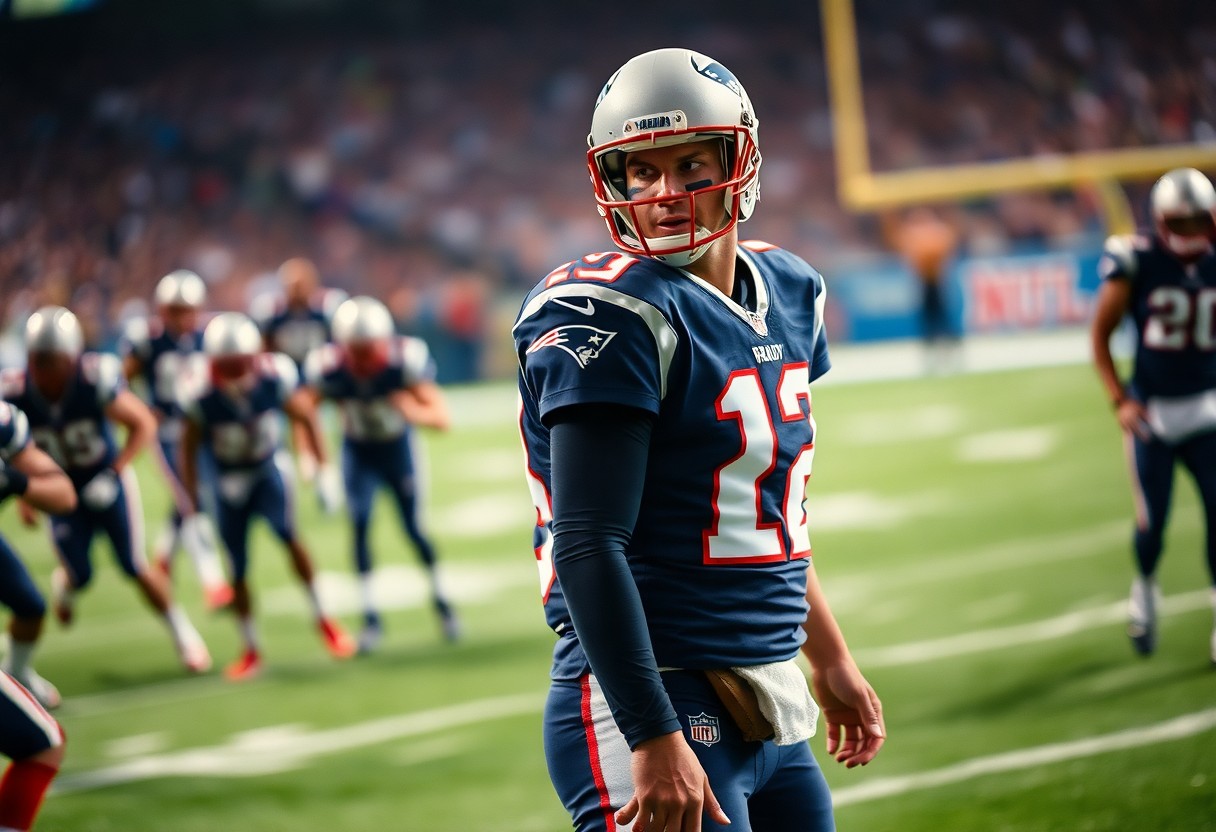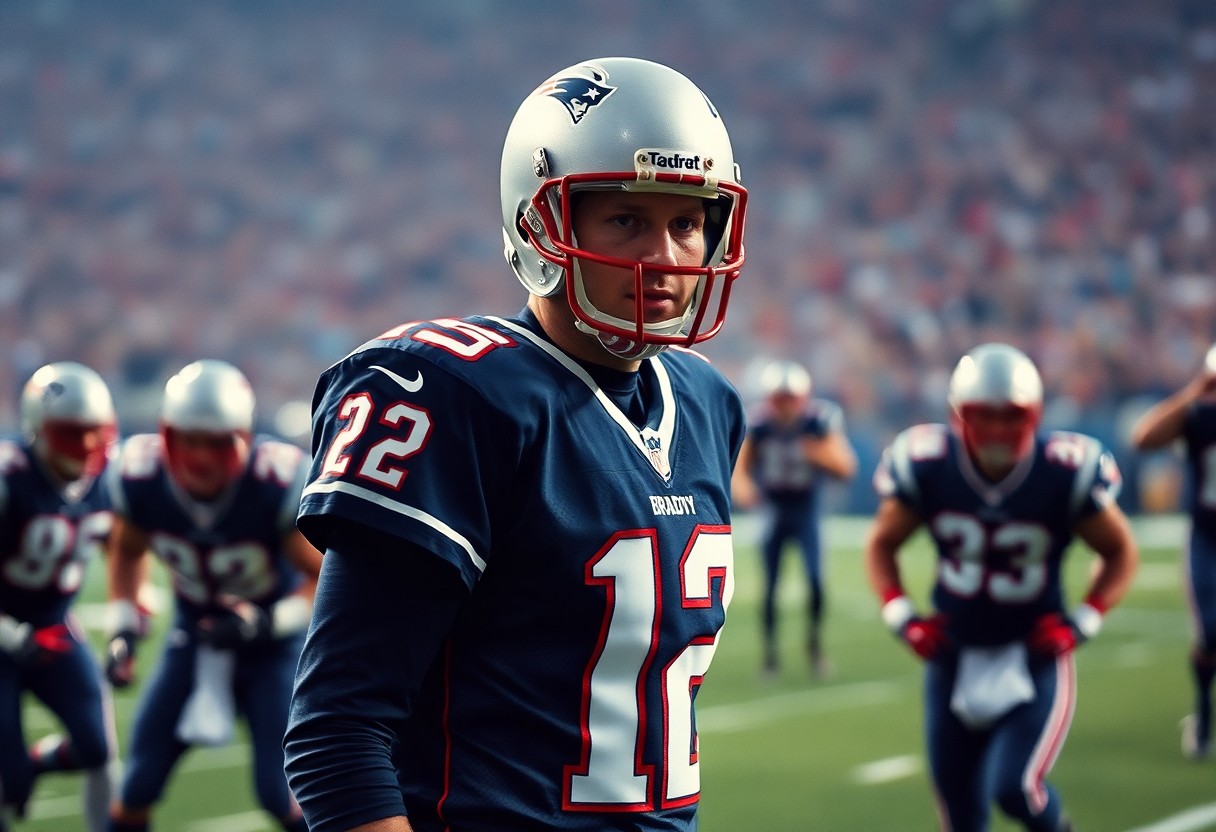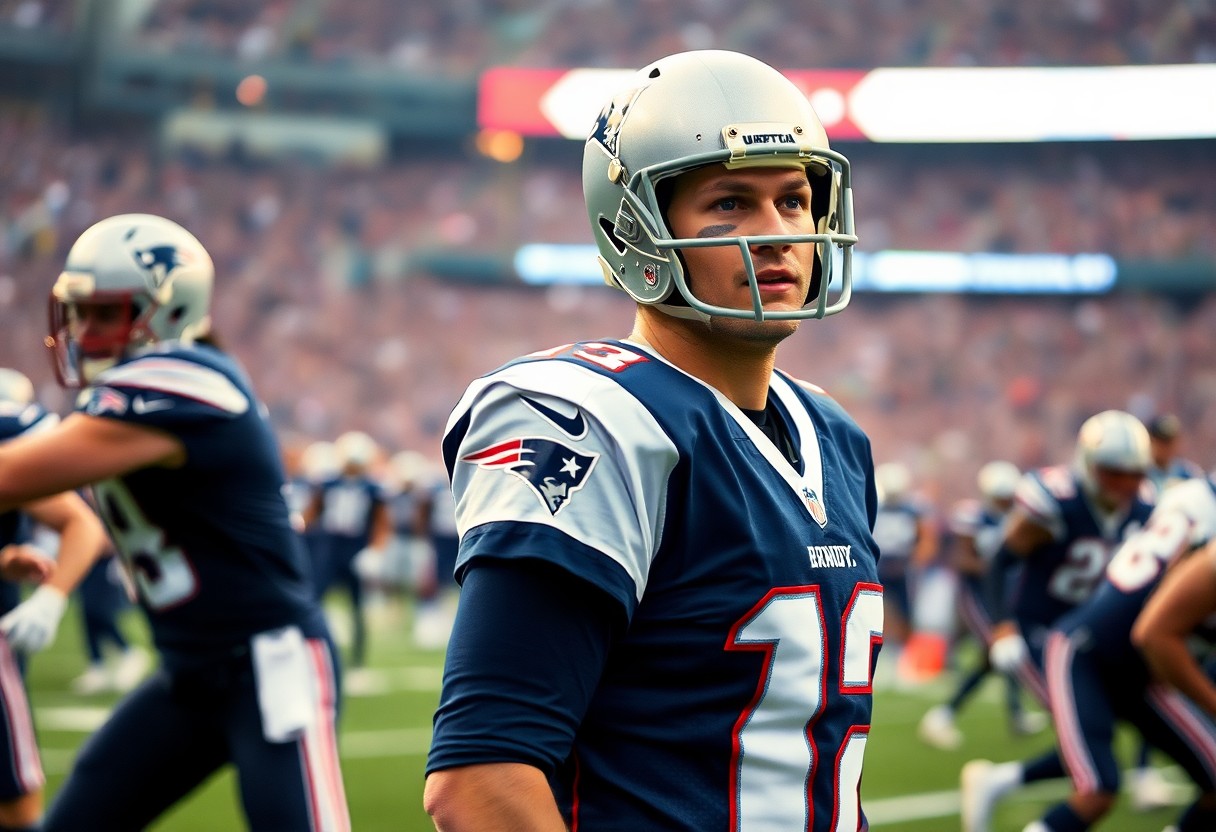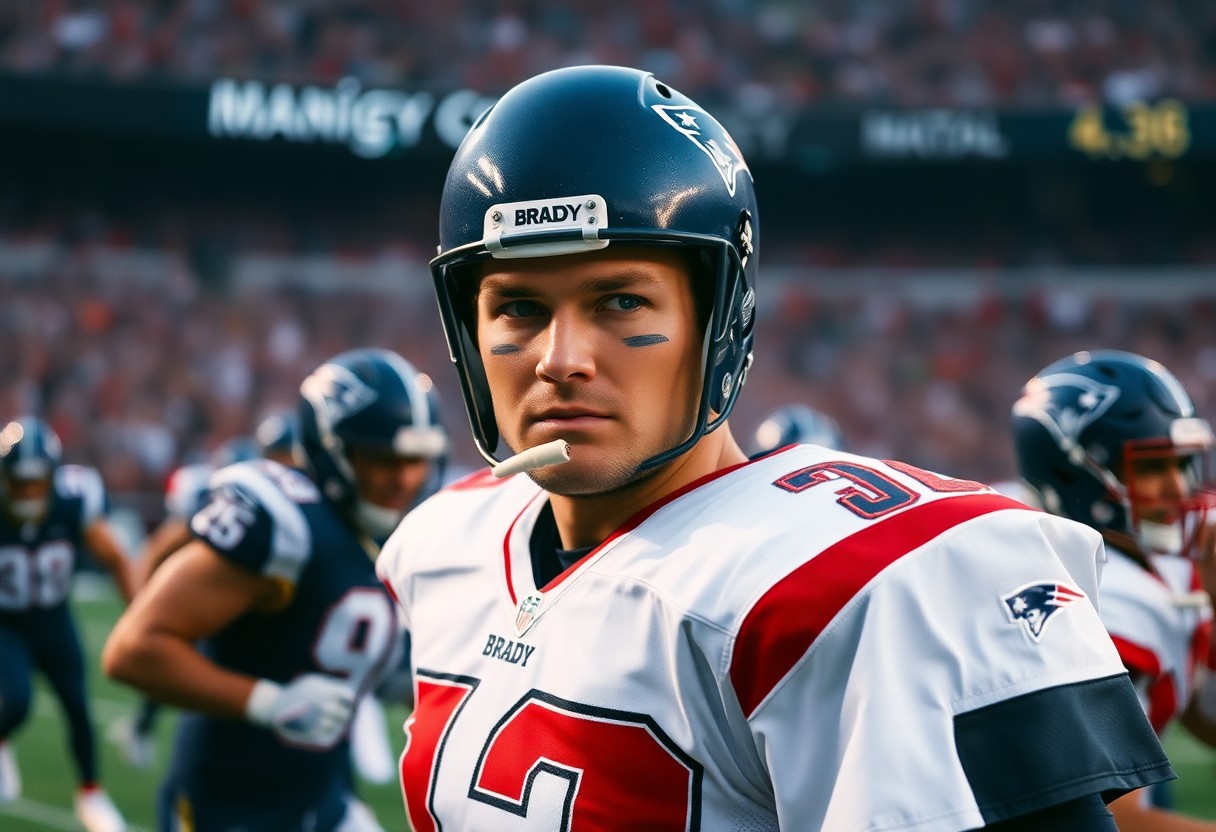The Unathletic NFL Star Who Destroyed Everyone – Tom Brady
With a slow 40-yard dash time and an unimpressive combine performance, you might have dismissed Tom Brady as just another quarterback prospect in 2000. Yet, what you couldn’t measure was his unmatched mental toughness and obsessive dedication to perfection. Despite being drafted 199th overall, Brady transformed himself into the greatest quarterback in NFL history, claiming seven Super Bowl rings and demolishing virtually every passing record. His success proves that you don’t need exceptional athleticism to dominate professional football – you need an unwavering will to win and relentless preparation.

The Early Years
While many NFL stars begin their journey as naturally gifted athletes, Tom Brady’s story proves that determination and mental fortitude can overcome physical limitations.
Growing Up in San Mateo
Growing up in San Mateo, California, you might be surprised to learn that young Tom Brady wasn’t the athletic specimen you’d expect from a future NFL legend. As a child, he showed remarkable dedication to improving himself, spending countless hours practicing in his backyard, despite not being the fastest or strongest kid on the block.
Your typical young athlete might have been discouraged by initial setbacks, but Brady’s early years were marked by his unwavering commitment to football. He would study game tapes with his father, analyzing every move of his idol Joe Montana. This period shaped his analytical approach to the game, which would later become his trademark.
You can trace Brady’s competitive spirit to his family dynamics, where he was the youngest of four children. This environment fostered his resilient mindset, as he constantly had to compete with his older siblings in various activities, developing the mental toughness that would define his career.
College Football Journey
Around 1995, when Brady arrived at the University of Michigan, you would have seen a young quarterback who was seventh on the depth chart. Your typical college athlete might have transferred, but Brady’s response was to work harder than everyone else, spending extra hours in the film room and on the practice field.
Your understanding of Brady’s college career should include the fact that he had to compete against Drew Henson, a highly touted recruit. Despite sharing playing time, Brady led Michigan to victory in the Orange Bowl and demonstrated his ability to perform under pressure.
You might be interested to know that during his final year at Michigan, Brady completed 62.8% of his passes and threw for 2,217 yards, showing glimpses of the quarterback who would dominate the NFL for decades to come.
In fact, your analysis of Brady’s college career reveals that he set multiple Michigan records, including most pass attempts in a game (56) and most completions in a game (34). These achievements would later prove to be mere stepping stones in his legendary career.
The Famous NFL Draft Position: #199
Below any reasonable expectation for a future Hall of Famer, you would have found Brady’s draft position in the 2000 NFL Draft. Six quarterbacks were selected before him, as teams were unimpressed by his combine performance and physical attributes.
Your perspective on draft analysis would be forever changed by Brady’s story, as he sat through 198 picks before the New England Patriots selected him. This moment became the chip on his shoulder that fueled two decades of excellence.
You might find it amusing now, but scouts criticized Brady’s lack of mobility and arm strength, focusing on what he couldn’t do rather than his exceptional mental processing and leadership qualities.
Hence, your understanding of Brady’s draft position should serve as a reminder that conventional metrics don’t always predict success. This historic oversight by NFL teams would lead to the greatest draft steal in sports history, as Brady went on to prove that mental toughness and determination can triumph over physical limitations.
Physical Limitations
Any discussion of Tom Brady’s remarkable NFL career must acknowledge the physical limitations that made his success even more extraordinary. Despite lacking the conventional athletic profile of an elite quarterback, Brady’s journey showcases how determination and intelligence can overcome natural physical constraints.
The “Dad Bod” Phenomenon
One of the most striking aspects of Brady’s physical appearance has been his notably average build, which you might recognize as the now-famous “dad bod.” Throughout his career, Brady’s physique has stood in stark contrast to the chiseled frames of peers like Cam Newton or Russell Wilson, yet this hasn’t hindered his unprecedented success spanning over two decades in the NFL.
You might find it surprising that Brady’s relatively unremarkable physical stature became part of his appeal to fans. His 6’4″ frame, carrying what many would consider an average build, made him more relatable to the everyday person. This image, combined with his exceptional performance on the field, helped create a unique narrative that challenged traditional expectations of what a professional athlete should look like.
Your understanding of athletic excellence might be challenged when you consider that Brady’s physique remained relatively unchanged throughout his career. While other quarterbacks focused on building impressive muscle mass, Brady maintained a lean, functional build that prioritized flexibility and longevity over aesthetic appeal, proving that physical appearance doesn’t dictate athletic success.
Speed and Agility Metrics
Limitations in Brady’s athletic abilities became evident when you look at his speed and agility measurements. His infamous 5.28-second 40-yard dash time at the NFL Combine ranks among the slowest for quarterbacks, and his mobility in the pocket has been a constant source of playful ridicule throughout his career.
You might notice that Brady’s limited athleticism forced him to develop other aspects of his game. His pocket presence and quick decision-making became legendary compensatory skills that transformed his physical limitations into unique advantages.
Your analysis of Brady’s movement patterns would reveal that he never developed into a dual-threat quarterback. Instead, he mastered the art of subtle pocket movements and quick releases, making his lack of speed virtually irrelevant to his success.
Indeed, when you examine Brady’s career statistics, you’ll find that his limited mobility actually contributed to his longevity. By avoiding unnecessary runs and focusing on quick releases, he minimized the physical toll on his body, allowing him to play at an elite level well into his forties.
Combine Performance Analysis
Across the history of NFL Combine performances, Brady’s numbers stand out for all the wrong reasons. Your review of his results would show underwhelming figures in virtually every category, from the vertical jump to the broad jump, placing him in the bottom percentiles among quarterback prospects.
You might be amazed to learn that these poor combine numbers almost prevented Brady from being drafted at all. His selection as the 199th pick in the 2000 NFL Draft reflected how little faith teams had in his athletic potential.
Your understanding of athletic evaluation would be challenged when you consider how Brady’s combine performance became a testament to the limitations of standardized athletic testing. His success proved that traditional metrics fail to measure the most important quarterback traits: leadership, decision-making, and competitive drive.
Combine statistics often paint an incomplete picture, and Brady’s case demonstrates why you shouldn’t solely rely on these metrics. His career serves as a powerful reminder that greatness can emerge from seemingly underwhelming physical attributes, fundamentally changing how teams evaluate quarterback prospects.

Mental Game Mastery
Unlike the physically gifted athletes who dominated the NFL through raw talent, Tom Brady’s path to greatness was paved through his extraordinary mental capabilities. His approach to the game revolutionized how quarterbacks prepare and perform at the highest level.
Film Study Dedication
Between meetings, practices, and games, you might wonder how Brady maintained his edge over two decades. The answer lies in his unmatched commitment to film study, often spending 40+ hours per week analyzing opponent footage. While other players headed home after practice, Brady would immerse himself in game tape, studying defensive patterns, coordinator tendencies, and individual player behaviors.
When you examine his preparation routine, you’ll find that Brady developed a systematic approach to film analysis. He would break down each defensive player’s stance, movement patterns, and pre-snap adjustments. This meticulous attention to detail allowed him to identify subtle tells that would reveal defensive coverages before the ball was even snapped.
Your understanding of Brady’s film study habits wouldn’t be complete without acknowledging his innovative use of technology. He pioneered the use of advanced analytics software to catalog and categorize defensive schemes, creating a personal database of tendencies that grew more valuable with each passing season. This digital library became his secret weapon, enabling him to recognize and exploit patterns that others missed.
Pre-snap Reading Abilities
At the line of scrimmage, Brady’s mental processing power truly set him apart. His ability to read defenses became legendary, as he could process multiple defensive alignments within seconds and adjust his offense accordingly. You’d often see him pointing out potential blitzers, shifting protection schemes, and changing plays entirely based on what he observed.
When you watch Brady’s pre-snap routine, you’ll notice his methodical approach to scanning the field. He developed a precise sequence for reading defensive alignments, starting with the safeties, then linebackers, and finally the defensive line. This systematic approach allowed him to decode complex defensive disguises that would fool lesser quarterbacks.
Through your analysis of Brady’s game, you’ll discover that his pre-snap excellence wasn’t just about reading defenses – it was about manipulation. He would use hard counts, fake audibles, and body language to bait defenders into revealing their true intentions, gaining a crucial advantage before the play began.
For instance, you might notice how Brady would often use the play clock to his advantage, waiting until the last possible moment to snap the ball. This gave him maximum time to analyze the defense while forcing them to show their hand or risk being caught out of position when the play began.
Decision-making Excellence
Behind Brady’s seven Super Bowl rings lies an unparalleled ability to make the right decisions under pressure. His split-second processing speed allowed him to choose the optimal receiver while facing down rushing defenders. You’ll find that his interception rate remained remarkably low throughout his career, showcasing his exceptional judgment.
When you study Brady’s game-winning drives, you’ll see a master class in decision-making. He consistently chose high-percentage plays that maintained possession while advancing the ball, rather than forcing risky throws. This conservative yet effective approach became his trademark in critical moments.
Your understanding of Brady’s success must include his ability to adapt mid-game. He could process new information and adjust his decision-making framework on the fly, making him virtually impossible to defend against for entire games. If one approach wasn’t working, he’d seamlessly transition to another, always staying one step ahead of the defense.
With each passing season, Brady’s decision-making became more refined, incorporating lessons learned from thousands of snaps. His ability to recognize and exploit defensive weaknesses while minimizing risks became almost computer-like in its precision, setting a new standard for quarterback play in the NFL.

The New England Dynasty
Belichick-Brady Partnership
One of the most remarkable aspects of NFL history unfolded when you witnessed Bill Belichick and Tom Brady joining forces in New England. Their partnership, which began in 2000, would revolutionize the way football was played and coached. What made this duo particularly lethal was their shared obsession with perfection and their ability to stay ahead of the competition through meticulous preparation.
You could see how their relationship evolved beyond the typical coach-quarterback dynamic. Belichick recognized Brady’s exceptional football IQ and gave him unprecedented autonomy at the line of scrimmage. This trust allowed Brady to make pre-snap adjustments and exploit defensive weaknesses in real-time, making the Patriots’ offense nearly impossible to predict.
Their collaborative approach to game planning set new standards in the NFL. You’d often hear stories of Brady and Belichick spending countless hours studying film together, dissecting opponents’ tendencies, and developing counter-strategies. This level of dedication and synergy resulted in a winning percentage of over .700 during their two-decade partnership.
System Adaptation
For those watching the Patriots closely, you’d notice how the offense evolved dramatically over the years. What started as a run-heavy approach transformed into a sophisticated passing attack that could adapt to any defensive scheme. Brady’s ability to master multiple offensive systems while maintaining elite performance levels showcased his exceptional football intelligence.
You could observe how the Patriots’ offense morphed from the power running games of the early 2000s to the spread formations of the late 2000s, and finally to the up-tempo, no-huddle attacks of the 2010s. Brady’s versatility allowed the team to reinvent their offensive identity multiple times, keeping opponents constantly off balance.
The system’s flexibility became your primary evidence of Brady’s greatness. Unlike other quarterbacks who excelled in specific schemes, Brady thrived in whatever system the team employed, whether it emphasized deep throws, quick releases, or complex option routes.
Indeed, when you analyze Brady’s career statistics, you’ll find that he maintained elite performance levels despite constant changes in personnel and offensive strategies. His ability to elevate the play of those around him, regardless of their experience or skill level, became a defining characteristic of the Patriots’ dynasty.
Championship Runs
After establishing themselves as perennial contenders, you watched the Patriots initiate on a series of historic championship runs. Each Super Bowl victory showcased different aspects of Brady’s excellence, from the game-winning drives against the Rams and Panthers to the historic 28-3 comeback against the Falcons.
Your understanding of Brady’s greatness deepened as you witnessed him lead fourth-quarter comebacks in three different Super Bowl victories. His ability to perform under pressure became legendary, with his decision-making and accuracy actually improving in the most critical moments.
The championship success spanned multiple eras of NFL football, proving that Brady could adapt and excel regardless of how the game evolved. You saw him win with power running games, spread offenses, and even in shootouts against some of the most explosive offenses in NFL history.
Dynasty isn’t a strong enough word to describe what you witnessed during the Patriots’ run. With six Super Bowl victories over eighteen years, Brady and the Patriots established a level of sustained excellence that you may never see again in professional sports.
Defying Athletic Standards
To understand Tom Brady’s unprecedented success, you need to look beyond conventional athletic metrics. While he never possessed blazing speed or a herculean physique, Brady’s mastery of the mental game and technical precision revolutionized quarterback play.
Pocket Presence Evolution
On the field, Brady’s pocket presence transformed from a basic survival skill into an art form. In his early years, you could see him learning to sense pressure, making subtle adjustments to avoid rushers while keeping his eyes downfield. This fundamental ability would later become one of his signature strengths, allowing him to extend plays without relying on athletic escapability.
As his career progressed, Brady developed an almost supernatural awareness of defensive movements. You could witness him manipulating the pocket with minimal movement, creating throwing lanes where none seemed to exist. This efficiency in movement became a masterclass in quarterback play, proving that elite mobility isn’t always about running ability.
The culmination of this evolution resulted in Brady’s ability to make the pocket his command center. When you watch his game films, you’ll notice how he turns perceived weaknesses into advantages, using his understanding of defensive schemes and timing to compensate for his limited athleticism. This adaptation made him virtually unsackable despite his lack of speed.
Mechanical Efficiency
One of Brady’s most remarkable achievements was developing perhaps the most efficient throwing mechanics in NFL history. Your typical quarterback might rely on raw arm strength, but Brady’s approach focused on maximizing every aspect of his throwing motion, from his footwork to his follow-through.
Through countless hours of practice, you could see Brady refine his release to become quicker and more compact. This mechanical precision allowed him to deliver the ball with exceptional accuracy while maintaining arm strength throughout four quarters, compensating for what he lacked in natural athletic gifts.
When you analyze his throwing motion, you’ll notice how Brady eliminated wasted movement, creating a repeatable process that remained consistent under pressure. This mechanical efficiency became his trademark, allowing him to make split-second decisions and releases that even more athletic quarterbacks couldn’t match.
Evolution of Brady’s mechanics continued throughout his career, as you could observe him making subtle adjustments to maintain effectiveness while reducing strain on his body. Any aspiring quarterback can learn from his relentless pursuit of technical perfection.
Longevity Factors
By examining Brady’s career longevity, you’ll discover a blueprint for athletic sustainability that defied conventional wisdom. His approach to conditioning and recovery revolutionized how players think about career extension, focusing on pliability and prevention rather than traditional strength training.
When you look at his dietary choices and lifestyle modifications, you’ll see a methodical approach to maintaining peak performance. Brady’s commitment to clean eating and proper hydration became legendary, setting new standards for professional athletes’ nutrition programs.
The mental aspect of his longevity proved equally important, as you could witness his competitive fire burning as bright in year twenty as it did in year one. Any discussion of Brady’s career must acknowledge his unmatched mental resilience.
- TB12 Method implementation
- Recovery-focused training
- Anti-inflammatory diet
- Sleep optimization
- Mental conditioning
Understanding Brady’s longevity requires looking at the complete picture of his lifestyle choices and training methods. His holistic approach to health and performance created a sustainable model for athletic excellence. Any player hoping to extend their career can learn from his example.
- Flexibility training
- Nutrition timing
- Recovery protocols
- Stress management
- Performance mindset
Training and Preparation
Not everyone starts their journey as a natural athlete, and Tom Brady’s transformation from an unremarkable college player to an NFL legend showcases the power of dedication and smart training. His approach revolutionized how professional athletes view longevity and performance optimization.
TB12 Method Development
Above all else, Brady’s TB12 method emerged from his collaboration with body coach Alex Guerrero, focusing on what you might call muscle pliability training. This innovative approach emphasizes the importance of keeping your muscles long, soft, and primed for optimal performance. Through years of experimentation and refinement, Brady developed a system that challenged traditional strength training paradigms.
When you look at the core principles of TB12, you’ll find a unique blend of resistance band exercises, neuroplasticity training, and functional movements. The method actively discourages heavy weightlifting, which Brady believes can lead to shortened, dense muscles that are more susceptible to injury. Instead, you’re encouraged to focus on exercises that promote flexibility and sustained power.
Your understanding of the TB12 method wouldn’t be complete without acknowledging its holistic approach. Brady integrated cognitive training, including brain exercises and visualization techniques, making it more than just a physical training program. This comprehensive system has helped him maintain peak performance well into his 40s, defying conventional wisdom about athletic longevity.
Diet and Lifestyle
With a foundation built on plant-based principles, Brady’s dietary approach might surprise you. He maintains an 80% alkaline, 20% acidic food balance, believing this ratio optimizes your body’s pH levels for peak performance. The diet eliminates common inflammatory foods, including nightshades, caffeine, and most processed foods.
Your daily routine under Brady’s system would involve drinking half your body weight in ounces of water, with added electrolytes. He advocates for early dinners and strict meal timing, ensuring your body has optimal periods for digestion and recovery. This approach helps maintain steady energy levels throughout the day.
In following Brady’s lifestyle principles, you’ll find yourself adhering to strict sleep schedules and environmental considerations. He emphasizes the importance of getting to bed by 8:30 PM and maintaining a cool, clean sleeping environment for optimal recovery.
Diet restrictions in Brady’s method might seem extreme to you, but they’re based on anti-inflammatory principles. The plan completely eliminates white sugar, white flour, MSG, iodized salt, and even certain vegetables that could potentially cause inflammation in your body.
Recovery Techniques
Training recovery in Brady’s system focuses heavily on what you do between workouts. He introduced innovative techniques like deep force muscle pliability work, which involves intensive massage and stretching to keep muscles long and soft. This approach helps prevent the muscle densification that often comes with traditional training methods.
Your recovery protocol under TB12 would include significant emphasis on sleep optimization and stress management. Brady advocates for regular meditation sessions and the use of resistance bands for active recovery, rather than traditional static stretching. This dynamic approach helps maintain muscle pliability while promoting blood flow and healing.
Through implementing these recovery techniques, you’ll find yourself focusing on prevention rather than treatment. Brady’s system includes pre-workout preparation routines that are just as important as post-workout recovery, creating a continuous cycle of maintenance and optimization.
Also worth noting is Brady’s use of cutting-edge recovery technology, including infrared pajamas, bioceramic-infused gear, and specialized vibration therapy. These tools, while sometimes unconventional, have helped him maintain his exceptional performance level throughout his career.
Statistical Dominance
Now, let’s explore the extraordinary numbers that define Tom Brady’s career, showcasing why he stands as the most statistically dominant quarterback in NFL history.
Regular Season Records
For anyone looking to understand Brady’s regular season mastery, you need only examine his staggering collection of NFL records. Throughout his 23-season career, Brady has amassed 89,214 passing yards and 649 touchdown passes, both of which stand as league records that might never be broken. You can see his excellence reflected in his remarkable consistency, maintaining a career completion percentage of 64.3% despite playing in various offensive systems and with countless different receivers.
When you look at Brady’s regular season win-loss record, you’ll find an almost unbelievable 251-82 mark as a starter. This translates to a .754 winning percentage – the highest among quarterbacks with more than 100 starts. Your understanding of his impact deepens when you consider that he’s led his teams to 19 division titles, another NFL record that demonstrates his sustained excellence over two decades.
You might be surprised to learn that Brady’s regular season achievements extend beyond traditional statistics. He holds the record for most Player of the Week awards (49) and has earned three regular season MVP awards. His ability to avoid interceptions while maintaining aggressive play stands out, with an exceptional interception percentage of just 1.8% throughout his career.
Playoff Performances
Regular season excellence merely set the stage for Brady’s playoff dominance. In the postseason, you’ll find Brady’s numbers reach even more remarkable heights. He holds virtually every major playoff passing record, including 13,400 passing yards and 88 touchdown passes, numbers that dwarf those of his nearest competitors.
When you examine Brady’s playoff win-loss record, you’ll discover an astounding 35-12 mark. To put this in perspective, you could take away half of his playoff wins, and he’d still rank among the top five quarterbacks in playoff victories. His ability to perform under pressure has resulted in 14 conference championship game appearances, a testament to his consistent excellence in the most high-stakes situations.
You’ll find that Brady’s playoff performance metrics often exceeded his regular season numbers, showcasing his ability to elevate his game when it mattered most. His completion percentage in playoff games stands at 62.8%, remarkable considering the increased defensive intensity and challenging weather conditions often present in postseason games.
Understanding Brady’s playoff dominance requires acknowledging that he has more playoff wins than 28 NFL franchises have in their entire history. This staggering statistic helps you grasp the unprecedented nature of his postseason success.
Super Bowl Achievements
One of the most compelling aspects of Brady’s career becomes apparent when you examine his Super Bowl performances. His seven Super Bowl victories stand alone in NFL history, surpassing any single franchise’s total. You’ll find that his Super Bowl passing yards (3,039) and touchdowns (21) are both NFL records, showcasing his ability to perform on the biggest stage.
When you analyze Brady’s individual Super Bowl performances, you’ll notice his remarkable ability to lead game-winning drives. In five of his seven victories, you can trace the win directly to his late-game heroics, including the largest comeback in Super Bowl history – a 28-3 deficit against the Atlanta Falcons in Super Bowl LI.
You might be amazed to learn that Brady’s Super Bowl experience alone would qualify him for the Hall of Fame. His 10 Super Bowl appearances are more than any NFL franchise has achieved, and his performance in these games has earned him five Super Bowl MVP awards, another NFL record.
Season after season, Brady’s Super Bowl achievements continued to accumulate, creating an insurmountable standard for future generations. Your appreciation of his legacy grows when you consider that he maintained this level of excellence across three different decades, adapting his game to evolving defensive schemes and rule changes while consistently delivering in the
Leadership Impact
Locker Room Influence
One of your first observations when studying Tom Brady’s career is his extraordinary ability to transform locker room dynamics. His presence alone elevated the competitive spirit of every team he joined, whether in New England or Tampa Bay. You could see how his teammates naturally gravitated toward his unwavering dedication and professional approach to the game.
Your understanding of Brady’s influence deepens when you examine how he handled adversity. During challenging seasons, he demonstrated an exceptional ability to maintain team morale and focus. You’d often find him organizing extra practice sessions, staying late to review game footage, and personally connecting with teammates to boost their confidence.
Your appreciation of Brady’s leadership style grows when you realize how he balanced being both a friend and a commander to his teammates. He created an environment where accountability met encouragement, pushing everyone to perform at their highest level while maintaining strong personal relationships.
Mentoring Young Players
Above all else, your analysis of Brady’s career reveals his exceptional commitment to developing the next generation of NFL talent. He consistently took rookie quarterbacks under his wing, sharing not just technical knowledge but also the mental aspects of the game that made him successful.
Your examination of his mentoring style shows how he emphasized the importance of preparation and patience. Brady would spend extra hours after practice working with young players, teaching them how to read defenses, make pre-snap adjustments, and maintain composure under pressure.
Your understanding of his impact on young players becomes clear when you see how many of his former understudies have gone on to become successful NFL starters. He created a legacy of leadership that extended far beyond his personal achievements.
For instance, your research would show how Brady mentored players like Jimmy Garoppolo and Jacoby Brissett, who later became successful NFL starters. He provided them with invaluable insights into professional football’s mental game, sharing techniques for film study, game preparation, and maintaining peak performance throughout a long season.
Cultural Change Agent
One of your most significant discoveries about Brady’s leadership is how he transformed team cultures. When he arrived in Tampa Bay, you could see an immediate shift in the organization’s mindset. He brought a championship mentality that permeated every aspect of the team’s operations.
Your analysis of his impact shows how he influenced not just players but entire organizations. From dietary habits to training methods, Brady’s TB12 method became a blueprint for professional excellence that many teammates adopted. You could see how his approach to longevity and performance changed how players viewed their careers.
Your understanding of Brady’s cultural influence extends to how he changed the perception of aging athletes. He proved that with proper preparation and mindset, you could compete at the highest level well into your 40s, challenging traditional notions about career longevity in professional football.
At the heart of your examination, you’ll find that Brady’s cultural impact went beyond wins and losses. He established a new standard for professional excellence in the NFL, showing how dedication, preparation, and leadership could transform not just individual careers but entire franchises.
The Tampa Bay Chapter
Late Career Renaissance
Among the most remarkable transformations in NFL history, you could witness Tom Brady’s late-career renaissance with the Tampa Bay Buccaneers. At an age when most quarterbacks had long retired, Brady made the bold decision to leave his 20-year comfort zone in New England and venture into uncharted territory.
When you look at his first season with Tampa Bay, you’ll notice how Brady didn’t just maintain his level of play – he elevated it. Despite joining a new team during a pandemic-restricted season, he managed to throw for 4,633 yards and 40 touchdowns, proving that his excellence wasn’t system-dependent. Your perception of what’s possible for a 43-year-old athlete had to be completely recalibrated.
If you followed Brady’s evolution in Tampa, you’d see how he brought a winning culture to a franchise that hadn’t reached the playoffs in 13 years. His influence extended beyond statistics – you could observe how he transformed the team’s mentality, making them believe they could compete with anyone. The leadership he displayed during this transition period became a masterclass in professional adaptation.
System Adaptation 2.0
Tampa Bay’s offensive system under Bruce Arians presented a stark contrast to what you’d seen from Brady in New England. The “no risk it, no biscuit” philosophy meant more deep throws and aggressive plays, forcing Brady to adapt his game significantly. What you witnessed was a complete reinvention of his playing style at age 43.
If you analyze Brady’s performance metrics, you’ll notice how he embraced the vertical passing game more than ever before. Your standard expectations of an aging quarterback taking fewer risks were shattered as Brady led the NFL in deep ball attempts during his first season with the Buccaneers.
When you examine the evolution of Brady’s game in Tampa, you’ll see how he merged his methodical approach with Arians’ aggressive philosophy. This hybrid style proved even more effective than either system alone, demonstrating Brady’s extraordinary adaptability.
With this new system, you could see Brady’s willingness to take calculated risks while maintaining his trademark efficiency. His completion percentage on passes over 20 yards improved significantly, showing that even in his mid-40s, he could enhance aspects of his game.
Additional Championship Success
Below the surface of Brady’s statistical achievements in Tampa Bay, you’ll find an even more impressive accomplishment: leading the Buccaneers to a Super Bowl victory in his very first season. Your understanding of what defines a championship team had to expand when you saw how quickly Brady could transform a franchise.
When you look at the 2020 playoff run, you’ll notice how Brady’s experience became invaluable. His ability to maintain composure in high-pressure situations helped the team navigate through three road playoff games before dominating the defending champion Kansas City Chiefs in Super Bowl LV.
If you study the impact of this championship, you’ll see how it cemented Brady’s legacy as the greatest quarterback ever. Not only did he win his seventh Super Bowl ring, but he did it with a new team, in a new conference, against all odds.
Adaptation became the hallmark of Brady’s Tampa Bay tenure, as you could see him continuously evolving his game to match the team’s needs. His ability to maintain elite performance while adjusting to new teammates, coaches, and systems showcased why he remained at the top of the sport for so long.
Redefining Athletic Success
Keep in mind that Tom Brady’s journey has completely transformed how you should view athletic success in the NFL. His story challenges the conventional wisdom about what makes a great quarterback, proving that mental acuity and strategic thinking can outweigh raw physical talents.
Traditional vs. Brady Model
Model athletes before Brady were expected to possess exceptional speed, agility, and arm strength. You could see this in how scouts would prioritize 40-yard dash times, vertical jumps, and throwing power during combines. This traditional approach often overlooked players who didn’t fit the conventional mold, potentially missing out on extraordinary talents who excelled in other areas.
When you look at Brady’s approach, you’ll notice a stark contrast. His model emphasizes pocket presence, quick decision-making, and precise ball placement over athletic spectacle. You can see how this shifted the paradigm, showing that a quarterback’s success isn’t necessarily tied to their ability to outrun defenders or throw 70-yard bombs.
Your understanding of quarterback excellence needs to account for how Brady’s model revolutionized the position. He demonstrated that meticulous preparation, football IQ, and adaptability could more than compensate for average athletic abilities. This new perspective has influenced how teams now evaluate and develop quarterback talent.
Impact on QB Evaluation
Evaluation methods have undergone a significant transformation because of Brady’s success. You’ll find that teams now place greater emphasis on mental processing speed, leadership qualities, and work ethic when scouting quarterbacks. This shift has opened doors for players who might have been overlooked in previous eras.
When you examine modern quarterback development, you’ll notice how Brady’s influence has led to a more holistic approach. Teams are investing more in mental preparation, film study, and situational awareness training, rather than focusing solely on physical attributes.
Your perspective on quarterback potential has likely changed as Brady showed that sustained excellence comes from continuous improvement rather than natural gifts. This has led to a more sophisticated evaluation process that considers both mental and physical attributes.
Traditional metrics like arm strength and mobility are now balanced against intangible qualities that Brady exemplified. You can see how teams have adapted their scouting methods to identify quarterbacks who demonstrate exceptional football intelligence and leadership potential.
Legacy Elements
An examination of Brady’s legacy reveals how he redefined success at the quarterback position. You can observe his influence in how young quarterbacks now approach the game, focusing on mental preparation and strategic understanding as much as physical training.
When you study Brady’s career, you’ll notice that his most significant impact wasn’t in revolutionizing how the position is played physically, but in demonstrating how dedication, preparation, and mental toughness can elevate average athletic ability to extraordinary heights.
Your view of quarterback development should consider how Brady’s example shows that longevity and sustained success come from adaptability and continuous learning rather than relying on natural athletic gifts.
At its core, Brady’s legacy teaches you that athletic success isn’t limited to those with exceptional physical gifts. His career proves that determination, intelligence, and methodical improvement can overcome perceived athletic limitations and redefine what’s possible in professional sports.
Media and Public Perception
Despite Tom Brady’s initial portrayal as an underdog, his journey through the media spotlight has been nothing short of remarkable, transforming from a relatively unknown sixth-round draft pick to one of the most recognizable figures in sports history.
Draft Day Narratives
With the 199th pick in the 2000 NFL Draft, you would have seen a moment that would later be etched in football history, though few realized it at the time. The footage of a visibly emotional Brady, fighting back tears as he waited through six rounds, has become iconic. The media narrative surrounding his selection painted a picture of a slow, unathletic quarterback from Michigan who might struggle to make an NFL roster.
When you look back at the scouting reports, they focused heavily on his perceived physical limitations. Analysts consistently pointed out his below-average arm strength, lack of mobility, and unremarkable combine performance. These assessments shaped the initial media coverage, with many outlets barely acknowledging his selection, treating it as just another late-round pick likely to fade into obscurity.
The draft day coverage would later become a cornerstone of Brady’s legend, as you can now see how dramatically wrong these early assessments were. Sports media regularly revisits this narrative, using it to illustrate the fallibility of traditional scouting methods and the importance of intangible qualities that Brady possessed in abundance.
Evolution of Image
With each passing season, you’ve witnessed Brady’s public image transform dramatically. From the unknown backup to the fresh-faced champion who led the Patriots to their first Super Bowl victory, his media portrayal began to shift. The early “game manager” label gave way to recognition of his growing mastery of the quarterback position.
As your understanding of Brady deepened, the media narrative evolved from focusing on his physical limitations to celebrating his mental acumen and preparation. His obsessive attention to detail, strict dietary regime, and unmatched work ethic became central themes in coverage, replacing the earlier emphasis on what he couldn’t do physically.
When you followed his career through the 2010s, you saw his image transcend sports, becoming a cultural icon. The media began covering everything from his personal life to his business ventures, creating a broader narrative about excellence and longevity in professional sports.
This transformation in media coverage reflected your changing perception of what makes a great quarterback. Brady’s success forced a reevaluation of traditional athletic metrics, emphasizing intelligence, leadership, and clutch performance over raw physical talent.
GOAT Debates
Above all other discussions in sports media, the debate about Brady’s status as the Greatest of All Time has dominated coverage for over a decade. You’ve seen how his unprecedented seven Super Bowl victories have shaped these conversations, making it increasingly difficult to argue against his claim to the title.
When you examine the media’s treatment of Brady’s achievements, you’ll notice how the conversation shifted from comparing him to his contemporaries to measuring him against the entire history of the sport. His longevity and sustained excellence have created a new benchmark for quarterback evaluation.
As you’ve followed these debates, you’ve seen how they’ve evolved from questioning whether Brady was elite to discussing whether anyone will ever match his achievements. The media’s focus has shifted to documenting his record-breaking performances and milestone moments, treating each season as another chapter in an unprecedented legacy.
Consequently, the GOAT debates have transcended traditional sports media, becoming a cultural touchpoint that even casual fans can engage with, solidifying Brady’s position as one of the most discussed and analyzed athletes in history.
Business and Brand Building
Commercial Success
Below, you’ll find that Tom Brady’s journey from the football field to the business world has been nothing short of remarkable. His estimated net worth of over $250 million isn’t just from his NFL salary. Brady’s commercial success stems from his carefully curated image as a winner, making him one of the most marketable athletes in history.
You might recognize Brady’s face from numerous high-profile endorsement deals with brands like Under Armour, UGG, Tag Heuer, and Intel. What sets him apart is his selective approach to partnerships, choosing only brands that align with his personal values and lifestyle. This strategy has helped him maintain authenticity while building a powerful personal brand.
Your understanding of Brady’s business acumen deepens when you look at his long-term partnership strategies. Unlike many athletes who chase quick endorsement deals, Brady has focused on building lasting relationships with brands, often taking equity stakes instead of just accepting flat fees. This approach has proved more lucrative and sustainable over time.
TB12 Empire
Along with his traditional business ventures, Brady’s most significant entrepreneurial achievement is the TB12 brand. The company, founded in 2013, has grown from a single performance center in Foxborough to a multi-million dollar wellness empire. TB12’s foundation rests on Brady’s personal approach to health and fitness, which you can now access through various products and services.
You’ll find that TB12’s success lies in its unique blend of modern sports science and holistic wellness approaches. The brand offers everything from supplements and protein powders to fitness equipment and virtual training sessions. What makes it stand out is its focus on pliability and prevention rather than traditional strength training methods.
Your wellness journey with TB12 can include personalized coaching, nutrition plans, and recovery techniques. The brand has expanded into digital platforms, making Brady’s methods accessible to anyone, anywhere. This digital transformation has helped TB12 reach a global audience and establish itself as a legitimate player in the wellness industry.
Another aspect of TB12’s success is its educational component. You can access detailed information about the TB12 Method through books, videos, and workshops, making it more than just a product line – it’s a complete lifestyle system that Brady has personally validated through his unprecedented longevity in the NFL.
Media Presence
Before Brady even retired, he was already laying the groundwork for a strong media presence. His social media strategy has been particularly noteworthy, with millions of engaged followers across platforms. You’ll notice his content strikes a perfect balance between professional insights, personal moments, and brand promotion.
Your exposure to Brady’s media ventures includes his production company, 199 Productions, named after his draft position. This company has already secured several high-profile projects, including documentaries and entertainment content. The strategy here is clear: Brady is positioning himself as a content creator and media mogul, not just a subject.
You can see Brady’s influence expanding through his $375 million broadcasting deal with Fox Sports, securing his place in NFL coverage for years to come. This move demonstrates his understanding of long-term value creation and his ability to leverage his expertise in new ways.
This media empire continues to grow as Brady explores new platforms and formats. You’ll find his presence in podcasting, streaming content, and even NFTs and digital collectibles, showing his adaptability to emerging trends and technologies in the media landscape.
Impact on Football Culture
Changed Scouting Methods
Below average athletic measurements at the NFL Combine would have typically eliminated prospects from consideration, but Tom Brady’s success forced teams to completely revolutionize their scouting approach. You can see how his story made scouts look beyond just the physical metrics and dig deeper into mental attributes, work ethic, and competitive drive.
When you examine modern scouting reports, you’ll notice how teams now dedicate significant resources to evaluating a prospect’s football IQ, leadership qualities, and ability to process information quickly. Brady showed that a player’s determination and intelligence could far outweigh their athletic limitations. This shift has opened doors for countless players who might have been overlooked in the past.
Your understanding of NFL scouting must include how Brady’s success led teams to develop more sophisticated evaluation methods. Organizations now employ psychological assessments, situational analysis, and in-depth character investigations as standard practice. This comprehensive approach to talent evaluation has become the gold standard across the league.
Quarterback Development
Impact on quarterback development programs across all levels of football has been profound since Brady’s emergence. You can trace many modern QB training techniques directly to his methodical approach to the position. His emphasis on perfect mechanics, footwork, and timing has become the blueprint for developing young quarterbacks.
When you look at quarterback coaching today, you’ll see an increased focus on mental preparation and film study, mirroring Brady’s famous attention to detail. Training programs now prioritize decision-making skills and pre-snap reads over raw physical abilities, revolutionizing how quarterbacks are groomed from high school through the pros.
Your modern quarterback must master the cerebral aspects of the position, a direct result of Brady’s influence. He demonstrated that superior preparation and mental processing could consistently overcome physical limitations, changing how coaches develop their signal-callers.
Plus, you’ll find that quarterback development now extends far beyond the practice field. Brady’s influence has led to specialized nutrition programs, sleep science integration, and advanced recovery techniques becoming standard elements of QB development at all levels.
Age Barrier Breaking
For decades, you would have seen NFL teams pushing quarterbacks toward retirement as they approached their mid-30s. Brady’s unprecedented longevity has shattered these age-related assumptions, proving that quarterbacks can not only play but excel well into their 40s with proper preparation and care.
When you examine his impact on veteran players, you’ll see how Brady’s success has extended careers across the league. His dedication to body maintenance and injury prevention has created a new paradigm where age is viewed as less of a limiting factor and more of a potential advantage in terms of experience and wisdom.
Your perspective on athletic prime has likely shifted because of Brady’s example. He showed that with proper training, nutrition, and recovery methods, players can maintain peak performance levels far beyond traditional expectations. This has influenced how teams manage their veteran players and plan for the future.
And if you look at the current NFL landscape, you’ll notice more teams willing to invest in older quarterbacks, with front offices and coaches understanding that experience and mental mastery can often outweigh the advantages of youth at the sport’s most important position.
Conclusion
To wrap up, you might find it fascinating that Tom Brady’s journey completely redefines what you’d expect from an NFL superstar. When you look at his combine photos from 2000, showing an unremarkable physique and subpar athletic metrics, you’d never guess this was the same person who would dominate professional football for over two decades. His 5.28-second 40-yard dash time and uninspiring vertical jump would make you wonder how he even made it to the NFL, let alone become its most decorated player.
You can learn valuable lessons from Brady’s transformation from the 199th draft pick to the greatest quarterback of all time. His story proves that your traditional athletic measurements don’t define your potential for success. Through his legendary work ethic, meticulous attention to detail, and unwavering dedication to improvement, Brady showed you that mental fortitude and strategic intelligence can far outweigh raw physical gifts. His approach to the game – studying defenses, perfecting his throwing mechanics, and maintaining peak mental conditioning – created a blueprint you can apply to any field.
When you examine Brady’s career, you’ll notice that his greatest achievement isn’t just his seven Super Bowl rings or his numerous records. It’s how he revolutionized the quarterback position and proved that longevity in a brutal sport is possible through proper preparation and adaptability. Your takeaway from Brady’s story should be that conventional metrics of success don’t always predict greatness. As you’ve seen through his journey, the combination of relentless determination, strategic thinking, and continuous self-improvement can help you overcome any perceived physical limitations and achieve extraordinary results in your chosen field.
FAQ
Q: How did Tom Brady overcome his physical limitations to become an NFL legend?
A: Despite being considered slow and unathletic, Brady compensated with exceptional mental preparation, precise footwork, and unmatched work ethic. He developed superior passing mechanics and football IQ, which allowed him to outperform more physically gifted quarterbacks throughout his career.
Q: What were Tom Brady’s combine numbers that made scouts doubt him?
A: Brady’s infamous 2000 NFL combine performance included a sluggish 5.28-second 40-yard dash, a mediocre 24.5-inch vertical jump, and an unimpressive quarterback photo showing his less-than-athletic build. These numbers led to him being selected 199th overall in the sixth round.
Q: How many Super Bowl championships did the “unathletic” Brady win?
A: Tom Brady won an unprecedented seven Super Bowl championships – six with the New England Patriots and one with the Tampa Bay Buccaneers. This makes him the most successful quarterback in NFL history, despite his physical limitations.
Q: What specific skills made Brady elite despite his athletic shortcomings?
A: Brady excelled at quick decision-making, reading defenses, perfect timing on throws, and maintaining exceptional pocket presence. His ability to process information rapidly and deliver accurate passes under pressure became his trademark attributes.
Q: How did Brady’s preparation methods differ from other NFL quarterbacks?
A: Brady developed an incredibly detailed approach to preparation, including strict diet regimens, extensive film study, and precise practice routines. He focused on mental repetitions and understanding defensive schemes rather than relying on athletic abilities to make plays.
Q: What impact did Brady’s success have on NFL scouting?
A: Brady’s rise from an overlooked sixth-round pick to NFL legend changed how teams evaluate quarterbacks. Scouts now place greater emphasis on mental processing, leadership qualities, and work ethic rather than focusing solely on physical attributes and athletic measurements.
Q: How long did Brady maintain his elite performance level despite being “unathletic”?
A: Brady played at an elite level for 23 seasons, retiring at age 45. He maintained his high performance through meticulous conditioning, advanced recovery methods, and adapting his game to compensate for his limited mobility, proving that athletic ability isn’t everything in professional football.
![]()













